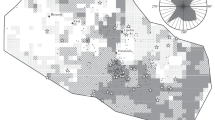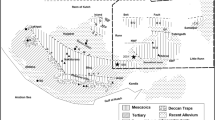Abstract
Structural–geological inhomogeneities in the northeastern Barents Sea are zoned based on an analysis of various components of the gravity and magnetic fields. The objects revealed in the basement and sedimentary cover of the Barents Sea Plate form anomalies in potential fields at coexisting complex geological structures and contrasting petrophysical properties. Cluster analysis reveals the fault-marked boundaries of individual blocks in the basement. A numerical model of faults in the sedimentary cover and basement of the Barents Sea Plate is constructed.
Similar content being viewed by others
References
S. V. Aplonov, G. B. Shmelev, and D. K. Krasnov, “Geodynamics of the Barents–Kara shelf: Geophysical evidence,” Geotectonics 30, 309–326 (1996).
Seas of the Arctic and Russian Far East, Vol. 5, Pt. 1 of Geology and Mineral Resources of Russia, Ed. by I. S. Gramberg, V. L. Ivanov, and Yu. E. Pogrebitskii (VSEGEI, St. Petersburg, 2004) [in Russian].
Barents Shelf Plate, Vol. 196 of Tr. Sevmorgeologiya, Ed. by I. S. Gramberg (Nedra, Leningrad, 1988) [in Russian].
N. A. Bogdanov, “Tectonics of the Arctic Ocean,” Geotectonics 38, 166–181 (2004).
V. I. Bondarev, Yu. P. Ershov, and B. S. Ipatov, “Tectonic evolution of the Northern Island of Novaya Zemlya,” in Geology and Stratigraphy of Novaya Zemlya (Sevmogeologiya, Leningrad, 1979), pp. 5–17.
M. L. Verba, “Crustal extension in the Barents Sea shelf,” in Natural Conditions and Resources of Northern Seas (Geogr. O-vo SSSR, Leningrad, 1977), pp. 28–32.
Geological Structure of USSR and Regularities of Mineral Resources Distribution, Vol. 9: Soviet Arctic Seas, Ed. by I. S. Gramberg and Yu. E. Pogrebitskii (Nedra, Leningrad, 1984) [in Russian].
State Geological Map of Russian Federation, Scale 1: 1000000 (New Series). Sheet R-38-40, Kolguyev. Explanatory Note, Ed. by B. G. Lopatin (VSEGEI, St. Petersburg, 2003) [in Russian].
I. S. Gramberg, “The Barents Sea Permo–Triassic paleorift and its importance to the problem of oil and gas potential of the Barents–Kara Platform,” Dokl. Earth Sci. 353, 198–200 (1997).
I. S. Gramberg, Yu. N. Kulakov, Yu. E. Pogrebitskii, and D. S. Sorokov, “Arctic petroleum-bearing superbasin” in Petroleum-Bearing Potential and of the World Ocean (PGOSevmorgeologiya, Leningrad, 1984), pp. 7–21.
I. S. Gramberg, V. I. Bondarev, N. N. Sobolev, and L. A. Daragan-Sushchova, “Reconstruction of the geological structure of the eastern Barents Sea region from the comprehensive analysis of geological-geophysical data,” in Russian Arctic: Geological History, Minerageny, and Geology (VNIIOkeangeologiya, St. Petersburg, 2002), pp. 193–201.
V. S. Zhuravlev and M. E. Raaben, “Hypothesis about the Barentia in the light of the modern data,” in Tectonics of the East European Platform and Its Framing (Nauka, Moscow, 1975), pp. 75–92.
L. P. Zonenshain and L. M. Natapov, “Tectonic evolution of the Arctic,” in Topical Problems of Oceanic and Continental Tectonics (Nauka, Moscow, 1987), pp. 31–56.
O. N. Zuikova and E. S. Mirolyubova, “Formation conditions and petroleum-bearing perspectives of the Lower Paleozoic deposits,” in Geological-Geophysical Characteristics of the Arctic Region Lithosphere (VNIIOkeangeologiya, St. Petersburg, 2006), Vol. 6, pp. 64–75.
A. M. Karasik, “Magnetic anomalies of the Gakkel Ridge and origin of the Eurasia superbasin, Arctic Ocean,” in Geophysical Survey Methods in the Arctic (NIIGA, Leningrad, 1968), Vol. 5, pp. 9–19.
E. A. Korago and T. N. Timofeeva, Magmatism of Novaya Zemlya, Vol. 209 of Tr. NIIGA-VNIIOkeangeologiya (St. Petersburg, 2005) [in Russian].
Soviet Arctic Seas, Vol. 9 of Geological Structure of USSR and Regularities of Mineral Resources Distribution (Nedra, Leningrad, 1984) [in Russian].
Novaya Zemlya and Vaigach Island: Geological Structure and Minerageny, Vol. 205 of Tr. NIIGA-VNIIOkeangeologiya (St. Petersburg, 2004) [in Russian].
Islands of Soviet Arctic, Vol. XXVI of Geology of USSR (Nedra, Moscow, 1970) [in Russian].
A. D. Pavlenkin, “Caledonian rifting in the Barents Sea shelf,” in Geological Structure of the Barents–Kara Shelf (PGO Sovmorgeologiya, Leningrad, 1985), pp. 29–33.
A. P. Piskaryov, Petrophysical Models of the Earth’s Crust in the Arctic Ocean, Vol. 203 of Tr. NIIGA-VNIIOkeangeologiya (St. Petersburg, 2004) [in Russian].
Yu. E. Pogrebitskii, “Geodynamic system of the Arctic Ocean and its structural evolution,” Sov. Geol., No. 12, 3–28 (1976).
T. S. Sakulina, M. L. Verba, N. M. Ivanova, Yu. V. Roslov, and I. V. Belyaev, “Deep structure of the northern Barents–Kara region along the 4-AR profile,” in Proceedings of the 7th Forum “Fuel and Energy Complex of Russia” (St. Petersburg, 2007), pp. 371–374.
Tectonic Map of the Barents Sea and Northern European Part of Russia, Scale 1: 2500000, Ed. by N. A. Bogdanov V. E. Khain, V. I. Bogatskii, S. L. Kostyuchenko, B. V. Senin, E. V. Shipilov, and S. F. Sobolev (PKO Kartografiya, Moscow, 1996).
N. I. Timonin, Pechora Plate: Geological Evolution in the Phanerozoic (Ural. Otd. Ross. Akad. Nauk, Yekaterinburg, 1998) [in Russian].
V. I. Ustritskii, “Tectonic nature of the Barents–North Kara megatrough,” in Problems of Petroleum-Bearing Potential of the World Ocean (Moscow, 1989), pp. 182–191.
V. I. Ustritskii and A. I. Khramov, “Geological evolution of the Arctic from the plate tectonic point of view,” in Soviet Arctic Seas, Vol. 9 of Geological Structure of USSR and Regularities of Mineral Resources Distribution (Leningrad, 1984), pp. 235–265.
M. D. Khutorskoi, V. R. Akhmedzyanov, A. V. Ermakov, Yu. G. Leonov, L. V. Podgornykh, B. G. Polyak, E. A. Sukhikh, and L. A. Tsybulya, Geothermy of the Arctic Seas (GEOS, Moscow, 2013) [in Russian].
M. D. Khutorskoi and B. G. Polyak, “Role of radiogenic heat generation in surface heat flow formation,” Geotectonics 50, 179–195 (2016).
L. A. Tsybulya, V. G. Levashkevich, O. A Zalivchii, and I. V. Shkola, “Heat flow in the Kara Sea and on its islands,” Geol. Geofiz., No. 11, 93–98 (1994).
B. K. Bhattacharya, “Continuous spectrum of the total magnetic field anomaly due to a rectangular prismatic body,” Geophysics 31, 97–121 (1966).
J. P. Burg, Unpublished Doctoral Dissertation (Stanford Univ., 1975).
V. K. Gupta and F. S. Grant, “Mineral exploration aspects of gravity and aeromagnetic survey in Sudbury-Cobalt area, Ontario,” in The Utility of Regional Gravity and Magnetic Anomaly Maps, Ed. by W. J. Hinze (1985), pp. 392–411.
I. N. Macleod, S. Vierra, and A. C. Chaves, “Analytic signal and reduction-to-the-pole in the interpretation of total magnetic field data at low magnetic latitudes,” in Proceedings of the Third International Congress of the Brazilian Geophysical Society, Rio de Janeiro, Brazil, 1993.
J. H. McClellan and H. Nawab, “Complex General-N Winograd Fourier Transform Algorithm (WFTA),” in Programs for Digital Signal Processing (IEEE Press, 1979), pp. 1.7-1–1.7-10.
A. Spector and F. S. Grant, “Statistical models for interpreting aeromagnetic data,” Geophysics 35, 293–302 (1970).
S. Winograd, “On computing the discrete Fourier transform,” Math. Comput. 32, 175–199 (1978).
Oasis montaj, Geosoft Software. http://www.geosoft. com/ru. Accessed March 5, 2017.
COSCAD-3D software complex for spectral correlation analysis of data. http://coscad3d.ru/. Accessed March 5, 2017.
Author information
Authors and Affiliations
Corresponding author
Additional information
Original Russian Text © D.S. Nikitin, P.P. Gorskikh, M.D. Khutorskoy, D.A. Ivanov, 2018, published in Geotektonika, 2018, No. 2, pp. 58–75.
Rights and permissions
About this article
Cite this article
Nikitin, D.S., Gorskikh, P.P., Khutorskoy, M.D. et al. Structural–Tectonic Features of the Northeastern Barents Plate from Numerical Modeling of Potential Fields. Geotecton. 52, 209–224 (2018). https://doi.org/10.1134/S0016852118020085
Received:
Published:
Issue Date:
DOI: https://doi.org/10.1134/S0016852118020085




